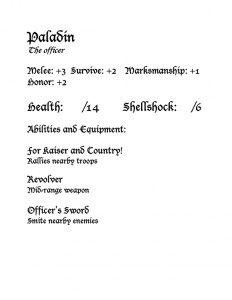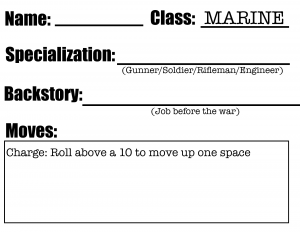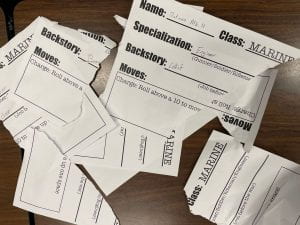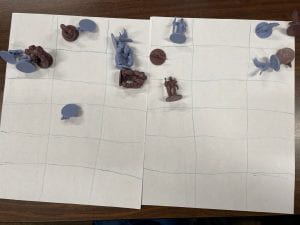“A big butcher’s bill was not necessarily evidence of good tactics.” – General Archibald Wavell in a telegram to Winston Churchill
A few months ago, the World War 1 game Beyond the Wire had a free weekend on Steam, and me and a couple of my friends wanted to try it out. When we got in game, we noticed that we were playing as soldiers of the German Empire in the year 1918. We proceeded to get absolutely destroyed by American and French forces and had no idea what we were doing. It was awesome. It truly captured the experience of being conscripted into the German Army in 1918.
While I originally intended to portray a fantasy version of the German Empire when I pitched this, I gradually became more interested in American involvement in the war the more I looked into WWI and what I wanted to do. The Battle of Belleau Wood stood out to me in particular, as it is viewed as the battle that gave the U.S. Marine Corps the fierce reputation they have today, and this was accomplished by charging into German machine gun fire through wheat fields and forests 6 times, the first 5 times just resulting in piles of dead marines. It was an interesting experience listening to the Sabaton song Devil Dogs, which focuses on the heroic bravery and ferocity of the marines which even at one point belts out the famous quote “Come on you sons of bitches, do you want to live forever?” while reading about how the marines were yet again slaughtered by machine gun fire after attempting another charge. It’s interesting to contrast the heroic and glorious nature of the song Devil Dogs with the other song on their album about WWI such as Great War and Fields of Verdun which portray the war as cruel and pointless.
I thought about how one of my friends once told me about how in challenging dungeons in older edition of D&D players would bring stacks of character sheets anticipating that they would often end up ripped in half at the DM’s feet. I felt that this would be a good mechanic to base my entire revised game around. I made and printed out mass amounts of simple character sheets that had a minimal amount of fluff attached to it to suggest players could try to put some element of humanity into the characters they are playing but ultimately it wouldn’t matter. I also brought some minis and a rudimentary map consisting of a grid players would try to charge through that would gradually fill up with the dead bodies (knocked over minis) of their previous character.
The rules were simple You needed to cross through 6 squares in order to charge the German position. On your turn, role a d20. If it is above a 10, move forward one square. If it is 10 or below, knock your mini over as it has died there, I rip your character sheet, then take a new character sheet and put a new mini on your starting square. This version of the game worked exactly as I wanted it to. Despite the simplicity of the objective, no one made it to the end of board. All there was to show for their efforts was a pile of ripped character sheets and a battlefield of dead minis.
Something I wanted to add to my game but couldn’t find a way to incorporate smoothly was the findings of the Nye Committee. In my opinion viewing American involvement in the war as simply pointless obfuscates the more horrific reason that additional lives were shipped across the world to suffocate in mustard gas. While Germany resuming the use of unrestricted submarine warfare was used as propaganda to mobilize the American population the Nye Committee uncovered a far more probable cause to explain American involvement. Before America officially entered the war, it had leant the Entente 2.3 billion dollars and the Central Powers only 27 million. It was therefore in the interest of American banks and finance, who had an enormous impact on U.S. formal policy as the committee also uncovered, to ensure that the Entente wasn’t the side burning a hyper inflated worthless currency after the war ended, not to mention the activities and influence of the arms industry who also stood to make massive profits if America was to officially enter the war. While I felt that this would be a good complement to the mass death I portrayed in my game, I couldn’t think of a way to seamlessly integrate this in a way that didn’t dilute what I wanted my game to express.
Ultimately, I drew a lot of inspiration from the Surrealist and Dada movements portrayal of World War I as pointless and cruel, and while one could portray a more modern version of that through contemporary wars such as Iraq, Afghanistan, or even Vietnam, I decided to keep the focus on WWI, not just because of my personal fascination with it, but because of its massive scale in which an almost unlimited amount of stories could be told, including the development of American imperialist ambitions and foreign policy that would shape its involvement in Vietnam, Afghanistan, and Iraq,
Attached are documentation of a character sheet from my first iteration of the game that was focused on a fantasy German Empire, a character sheet for my second and final iteration as well as a pile of them ripped up, a map full of dead minis, and a deep fried image of a painting of the Battle of Belleau Wood that summarizes everything I’ve tried to do here, as well as a google drive link where higher resolution version of these images can be found.





